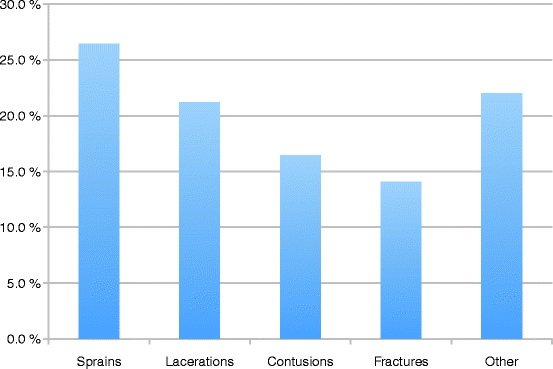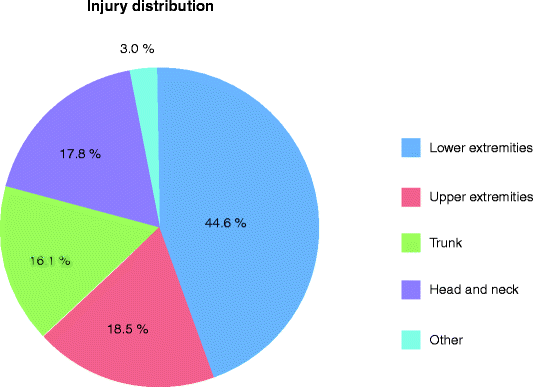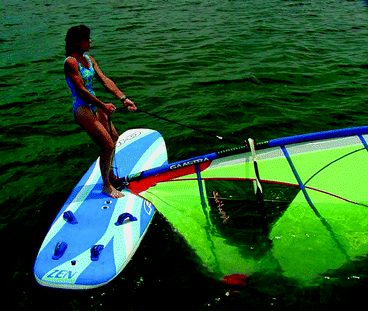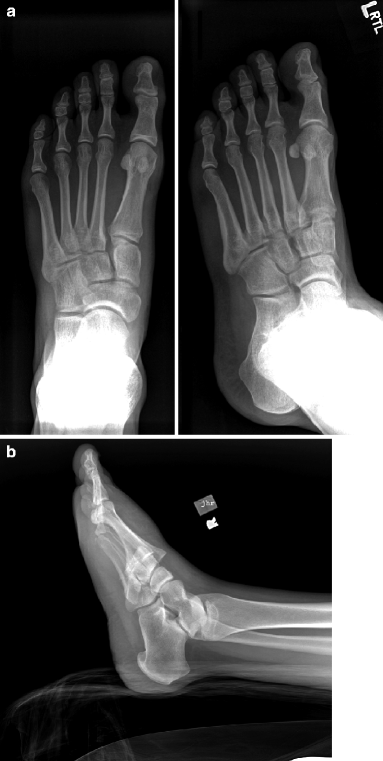Fig. 9.1
Wave jumping and wave riding (Photos: Ronen Topelberg)
Equipment and Basic Technique
The main piece of equipment is an 8- to 12-ft-long plastic or fiberglass-covered board with fins on the underside of the stern. Synthetic sails of varying sizes can be attached to a free-pivoting mast that rises from the center of the board. The windsurfer holds on to a chest-high boom. An optional harness attached to the boom supports the waist, allows the body weight to counteract the pull of the wind, and relieves pressure on the arms and lower back. The feet can be inserted under straps at the rear of the board for improved stability and steering in high winds. Additional equipment includes a wet or dry suit, footwear, helmet, and personal flotation device; however, there are no specific laws or guidelines dictating their use.
A sailboard will move by either sailing or hydroplaning (planing). Sailing takes place in light winds and involves the hull moving through the water using a centerboard and fin for stability. Weighting one side of the board or sinking the tail changes direction. When winds reach higher speeds (over 10–15 knots), the board begins to plane the top of the water. The fin still provides some lateral resistance for stability. Engaging one of the edges of the board will “jibe” or “carve” or turn the board over the water. Bringing the mast forward or backward will help steer the board during sailing, but transferring weight to either side of the board is the primary means of controlling the board during planing.
Injuries
Incidence
Despite routinely reaching speeds of 30 mph and jumps of 10–15 ft, windsurfing is a relatively safe sport. One retrospective study found approximately 1 injury per 1,000 sailing days [6]. A retrospective study comparing injury epidemiology in competitive raceboarders, competitive wave/slalom boarders, and recreational windsurfers found an annual injury incidence of just 1.0, 2.0, and 1.2, respectively [7].
Due to the unique equipment used and the often extreme conditions of wind and water, serious injuries do occur. A study performed in Greece in 2002 found 22 cases of severe accidents sustained during windsurfing in the Aegean Sea during a 12-month period. Prolonged hospitalizations, severe disability, and two deaths occurred as a consequence of the injuries. The types of accidents included drowning and near-drowning, spine fracture, concussion, facial fracture, shoulder dislocation and fracture, lower limb fracture, and large or deep lacerations [8].
The most common types of injuries include sprains (26.3 %), lacerations (21.2 %), contusions (16.2 %), and fractures (14.2 %) [6]. One more recent study found muscle/tendon strains to account for as much as a third of all injuries [7] (Chart 9.1). Less common occurrences include dislocations, disk herniations, jellyfish stings, hypothermia, near drowning, and concussions [6].


Chart 9.1
∎Windsurfing injuries by type
The most frequently affected body areas of windsurfers are the lower extremities (44.6 % of acute injuries), the upper extremities (18.5 %), the head and neck (17.8 %), and the trunk (16 %) [6] (Chart 9.2).


Chart 9.2
Windsurfing injuries by body area affected∎
Injuries can be specific to the skill level of the athlete and surfing discipline. In general, wave/slalom windsurfers have more new and recurrent injuries compared to raceboarders and recreational windsurfers [7].
The longer, heavier boards used in raceboarding can lend to more chronic tendinopathies and muscle strains compared to the other disciplines. A British study in 2006 found that muscle and tendon strains made up over half of all injuries in raceboarders [7].
For wave/slalom windsurfers, collision with equipment in powerful winds and high waves are a major contributory factor to injury occurrence [7].
Ligament sprains in the ankle and foot are more common in recreational windsurfers, while ligamental injuries of the knee are more common in the wave/slalom athletes [7].
The prevalence of back strain is significant in all groups. Uphauling the sail out of the water seems to be a particularly risky maneuver for lumbar muscular strain in longboard sailors [7] (Fig. 9.2). The risk of acute injuries is greater in high winds, while chronic lower back pain occurs predominately during lighter wind conditions, likely due to prolonged maintenance of a lordotic posture [9].


Fig. 9.2
Uphauling a sail on a longboard
During strong wind conditions, women have nearly twice the incidence of injury of men [9]. This is the only reported gender difference in injury epidemiology to date.
Lower Extremities
Injuries to the ankles and feet can be quite severe, and nearly half are fractures or ligament damage [6]. About 75 % of fractures and ligament injuries result from falling while the foot is engaged in the strap [6]. Being thrown off the sailboard with the strap still across the dorsum of the foot can apply significant counteractive forces across the ankle and foot.
Lisfranc Dislocation or Fracture
The common traumatic mechanism of the foot strap mandates high suspicion for a Lisfranc dislocation or fracture in any windsurfer with midfoot pain, especially if the pain is reproduced by passive pronation and abduction of the forefoot while the hindfoot is fixed. Weight-bearing radiographs in the anteroposterior and lateral planes plus a 30° oblique view should be obtained to look for the characteristic findings.
The x-ray findings for Lisfranc fracture can be subtle and are missed in as many as 20 % of cases [10] (Fig. 9.3 – collage). Comparison views of the other foot can help the clinician distinguish between subtle and normal x-ray findings. If initial radiographs appear negative, vigilance is still required because this injury may not always be evident on plain films. Continued midfoot pain and swelling and difficulty bearing weight 3–5 days post-injury demand further imaging, such as a computed tomography scan [11].


Fig. 9.3
Lisfranc joint injury radiographs: AP view (left), notice subtle widening between base of first and second metatarsals and lack of congruence between the medial edges of the second metatarsal and second cuneiform. A positive “fleck sign”, not present in this example, would be a small avulsion fragment off the base of the second metatarsal found in this same space. Oblique view (right): look for lack of alignment between the medial edges of the third metatarsal and third cuneiform (not found in this example). Lateral view, look for a step off deformity when tracing a line along the superior aspect of the second metatarsal to the tarsals
Some minor tarsometatarsal sprains may be treated nonsurgically with casts, but Lisfranc injuries usually require referral to an orthopedic surgeon. Most authors feel that surgical fixation is necessary to achieve precise anatomic reduction [10–13]. Early and accurate diagnosis is the best way to prevent long-term morbidity.
Knee and Leg Injuries
There are two case reports of injury to the lower leg due to foot fixation. A 27-year-old man fractured his lower leg, and an 18-year-old man sustained an ACL and MCL rupture during windsurfing. In both cases, the patients reported a twisting force on their legs and their feet being fixed in foot straps [14].
Chronic Injuries
Foot straps have also been blamed for two cases of extensor digitorum longus tendonitis published in the windsurfing literature. The persistent loading that foot straps create across the midfoot during planing was the proposed mechanism [15]. In both cases, the surfers were positioning their straps across the metatarsophalangeal joints as opposed to the midfoot. Treatments with rest, nonsteroidal anti-inflammatory drugs, physiotherapy, and repositioning the feet with the straps across the midfoot were successful. The surfers returned to full activity.
Thus, there is some controversy regarding foot straps from an injury prevention perspective. Certainly, a quick release mechanism is desirable to prevent the described fracture and ligament injuries. However, ideal placement of the straps is less clear. Though any position comes with its inherent risks, it seems that placing the foot so that the strap crosses the metatarsophalangeal joint avoids a more severe acute injury such as the Lisfranc fracture while risking the development of a less severe condition such as extensor digitorum tendonitis.
Upper Extremities
Shoulder Dislocation
The classic windsurfing injury of the upper extremity is a shoulder dislocation. The usual mechanism involves hanging on to the boom during a fall, which can anteriorly dislocate the humeral head. We have not seen a posterior shoulder dislocation from windsurfing.
On the scene, an attempt at reduction can be made before muscle spasm sets in but only if the care provider is experienced with shoulder injuries. It is important to perform a complete neurovascular exam of the injured limb, including an assessment of deltoid contraction, before reduction is attempted to determine if an associated axillary nerve injury is present. If reduction is not attempted, the arm should be immobilized in the adducted position before transporting the patient to emergency care.
Nerve Injuries
Peripheral nerve injuries due to blunt trauma, acute stretch, and exertional compression have been reported in the literature.
In one case study, a 21-year-old male experienced a sharp daggerlike pain in his shoulder while uphauling. He later developed posterior shoulder muscle atrophy and weakness consistent with a suprascapular neuropathy. EMG study results at that time were not made available, but following 6 months of conservative therapy and rest, the patient was asymptomatic and returned to windsurfing without limitation [3].
A 3-year study by Cininglio et al. identified 23 windsurfers with exertional upper extremity pain, paresthesia, and weakness compatible with transient compression of the posterior interosseus nerve during windsurfing. All athletes complained of exertional weakness of the wrist extensor muscles. Symptoms were relieved by elbow flexion, wrist flexion, supination, and support with the contralateral hand. A retrospective analysis of the 23 athletes’ windsurfing positions noted that 19 held the boom with their forearms in pronation. All athletes were treated with 2 weeks of rest, given physiotherapy, massage, and ultrasound therapy. They were coached to hold the boom with the forearm in supination. The majority of the athletes reported complete alleviation. Symptoms eventually returned in only five athletes, and they were treated with casting of the elbow at 90° with the forearm supinated and wrist in neutral position for 10 days. One of the casted athletes had recurrent symptoms, and surgical exploration of his posterior interosseus nerve revealed fibrosis in the arcade of Frohse where it contacts the nerve [3].
Stay updated, free articles. Join our Telegram channel

Full access? Get Clinical Tree








